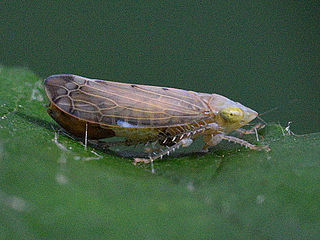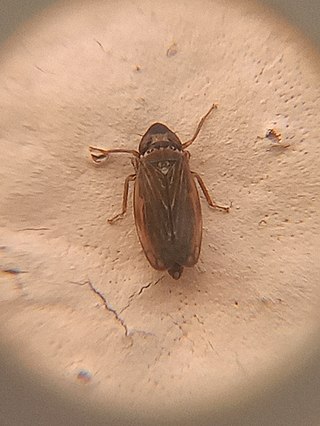
Deltocephalinae is a subfamily of leafhoppers. Deltocephalinae is the largest subfamily in the family Cicadellidae and is divided into 40 tribes, comprising over 925 genera, and over 6,700 described species.

Japananus hyalinus, the Japanese maple leafhopper, is a species of leafhopper of the subfamily Deltocephalinae and tribe Opsiini. Believed to be native to eastern Asia, it has been carried with the trade in cultivated maples and is now widely found in Europe, North America and Australia.

Fieberiellini is a tribe of leafhoppers in the subfamily Deltocephalinae. In the review by Zahniser & Dietrich (2013) it includes 48 species placed in 10 genera. Species in this tribe are native to the Palaearctic region, mainly the southern parts, with some being adventive in the Nearctic. The Cherry Leafhopper is a vector of several phytoplasma diseases including Cherry X Disease.

Athysanini is a tribe of leafhoppers in the subfamily Deltocephalinae. The type genus of the tribe is Athysanus. The tribe has a cosmopolitan distribution. It is the largest tribe in the subfamily Deltocephalinae and has 228 genera and at least 1120 species.

Phlepsiini is a tribe of leafhoppers in the subfamily Deltocephalinae. There are 4 genera and over 80 described species in Phlepsiini.

Scaphoideini is a tribe of leafhoppers. There are 64 genera and over 600 described species in Scaphoideini.
Arrugada is a genus of leafhoppers in the subfamily Deltocephalinae. There are currently four described species of Arrugada and they are all endemic to Bolivia and Peru. The genus was formerly considered to be within its own separate subfamily within Cicadellidae; however, it is now recognized to be in its own tribe, Arrugadini, within the subfamily Deltocephalinae.
Bonaspeiini is a tribe of leafhoppers in the subfamily Deltocephalinae. Bonaspeiini is made up of 26 genera and over 125 species found throughout southern Africa. Many species are found in the fynbos biome.
Chiasmini is a tribe of leafhoppers in the subfamily Deltocephalinae. Chiasmini contains 21 genera and over 300 species. Some species of Chiasmini in the genus Nephotettix are agricultural pests and transmit rice Tungrovirus in southeast Asia.
Cicadulini is a tribe of leafhoppers in the subfamily Deltocephalinae. There are 15 genera and over 120 species in Cicadulini.
Cochlorhinini is a tribe of leafhoppers in the subfamily Deltocephalinae. The tribe is endemic to the western United States and adjacent parts of Mexico, however at least one species has been introduced to Chile. Cochlorhinini contains 11 genera and over 140 species.
Dorycephalus is a genus of leafhoppers in the subfamily Deltocephalinae. It is the only genus in the tribe Dorycephalini. There are currently only two described species in the genus. The members of the genus are found in eastern Europe, Russia and Mongolia.
Faltalini is a tribe of leafhoppers in the subfamily Deltocephalinae. Faltalini is distributed from the southwestern United States south to Argentina and Chile. It contains 11 genera and over 25 species.
Goniagnathini is a tribe of leafhoppers in the subfamily Deltocephalinae. Goniagnathini contains 4 genera and around 60 species. Of these, one new species, Goniagnathuscornutus was recently verified in China.
Hypacostemma is a genus of leafhoppers in the subfamily Deltocephalinae. It is the only genus in the tribe Hypacostemmini. Hypacostemma contains at least 5 described species distributed throughout Southern Africa. Hypacostemma are usually large greenish leafhoppers with a length between 7-10 mm.
Koebeliini is a tribe of leafhoppers in the subfamily Deltocephalinae. There are 6 genera and over 15 species divided into two subtribes within Koebeliini: Koebellina and Grypotina. Koebeliina species are endemic to western North America.
Occinirvana eborea is a species of leafhopper in the subfamily Deltocephalinae. It is the only member of the genus Occinirvana and the tribe Occinirvanini, making them both monotypic taxa. O. eborea is endemic to Western Australia. It is closely related to Loralia, another genus of leafhoppers endemic to Australia.
Paralimnini is a tribe of leafhoppers in the subfamily Deltocephalinae. Paralimnini contains 139 genera and over 900 species divided into two subtribes: Aglenina and Paralimnina. The tribe has a cosmopolitan distribution.

Stenometopiini is a tribe of leafhoppers in the subfamily Deltocephalinae. It contains 8 genera and around 100 species. The members of Stenometopiini are widespread and have a cosmopolitan distribution.
Tetartostylus is a genus of leafhoppers in the subfamily Deltocephalinae. It is the only genus is the monotypic tribe Tetartostylini. Tetartostylini also used to include the genus Hiltus, but Hiltus is now placed in the tribe Paralimnini.








